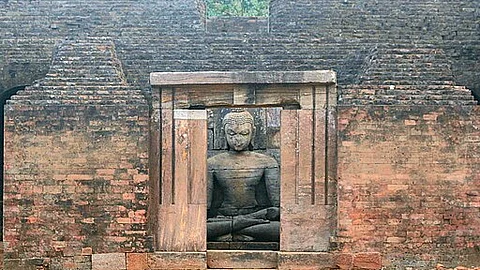
- Destinations
- Experiences
- Stay
- What's new
- Editor’s Picks
- Responsible Tourism
- CampaignsCampaigns
- Subscribe

If you are fond of history and love to travel off the beaten track, then Odisha's Diamond Triangle—Lalitgiri, Udaygiri and Ratnagiri—should be on your must-see list. These centres of Buddhist learning are only 100 kms from Odisha's capital, Bhubaneswar.
Odisha, or Kalinga as it was then known, is where Emperor Ashoka of Magadh had a change of heart. Renouncing war and violence, he not only converted to Buddhism but ensured it spread far and wide. Dhauli, near Bhubaneswar, marks the spot where the emperor went through the transformation after seeing the river Daya turn red with the blood of slain soldiers.
But to discover how deeply Buddhism had taken a root in the state, you have to travel to the Buddhist sites scattered across Odisha. About 100 kms from Bhubaneswar, lie what is popularly known as the Diamond Triangle. Consisting of three major ruins, Lalitgiri, Ratnagiri and Udaygiri, span centuries, displaying the evolution of Buddhism in Odisha. Unfortunately, the trio has remained off the popular tourist trail yet the combination of mahaviharas, stupas and sculptural treasures, found here shows they are no less attractive than Sanchi or Sarnath.
The oldest among the three is Lalitgiri, which dates back to the first century BCE. The site continued to develop over the next few years. A Mahastupa perched on a hillock overlooks the surrounding stupa complex, brick monasteries and a chaitya hall. It is said that caskets containing Buddha's tooth relics were found at the Mahastupa. The museum displays sculptures reflecting the Mahayana style, including large statues of Buddha, Bodhisatta and Jambhala. It is said that many of the statues found here bear a resemblance with those found in Java and other south-east Asian countries.
Udaygiri (not to be confused with the hill of the same name near Bhubaneswar) and Ratnagiri belong to a much later period. Udaygiri consisted of two monasteries -- Madhavapura Mahavihara and Simhaprasta Mahavihara -- and is located in the middle of horse-shoe shaped hill. A flight of steps lead to the top of the hill. Do not miss the panoramic view of the countryside from here.
A statue of Lokesvara holding a lotus stands at the base of the hill. Ruins of monasteries, brick stupas, and a stepwell are some of the key attractions here. Richly carved statues of Dhyani Buddha, Bodhisattva, Avalokiteshvara, Jambhala and Heruka, lie among the ruins.
According to historians, Ratnagiri, founded in sixth century, along with Udaygiri, was a seat of Tantric Buddhism. This centre flourished until 12th century. Excavations have revealed ruins of sprawling monasteries, rows of votive stupas, shrines and richly sculpted doorways and statues. The main monastery complex contains a large statue of Buddha in the Bhumisparsha mudra.
On either side stand are statues of Padmapani and Vajrapani. The courtyard serves as an open-air gallery where Buddha statues are on display. It is the only Buddhist monastery in India with a curvilinear roof. Did you know that monks from here went to teach at Nalanda?
The Diamond Triangle is around 100 kms north-east of Bhubaneswar. It is possible to see the trio on day's visit but you have to start early in the morning. A round trip from Bhubaneswar will take five to six hours, excluding the time spent at the three Budhhist centres. We suggest you go to Lalitgiri first, the furthest among the three, then Udaygiri and Ratnagiri, which are on the same route. Accommodation is scarce. The trio can also be visited from Cuttack, where OTDC has a tourist lodge.
The best time to visit the Diamond Triangle is during winter. The sun can be strong during the day so carry sun-protective gear. Also carry drinking water and food. Remember, the area is off the regular tourist circuit and can be lonely at times. A visit to the Diamond Triangle can be combined with a visit to the Bhitarkanika Wildlife Sanctuary.
